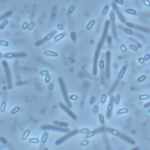Link to Pubmed [PMID] – 1938955
J. Bacteriol. 1991 Dec;173(23):7589-98
The pilE gene of Neisseria gonorrhoeae MS11 and a series of pilE-phoA gene fusions were expressed in Escherichia coli. The PhoA hybrid proteins were shown to be located in the membrane fraction of the cells, and the prepilin product of the pilE gene was shown to be located exclusively in the cytoplasmic membrane. Analysis of the prepilin-PhoA hybrids showed that the first 20 residues of prepilin can function as an efficient export (signal) sequence. This segment of prepilin includes an unbroken sequence of 8 hydrophobic or neutral residues that form the N-terminal half of a 16-residue hydrophobic region of prepilin. Neither prepilin nor the prepilin-PhoA hybrids were processed by E. coli leader peptidase despite the presence of two consensus cleavage sites for this enzyme just after this hydrophobic region. Comparisons of the specific molecular activities of the four prepilin-PhoA hybrids and analysis of their susceptibility to proteolysis by trypsin and proteinase K in spheroplasts allow us to propose two models for the topology of prepilin in the E. coli cytoplasmic membrane. The bulk of the evidence supports the simplest of the two models, in which prepilin is anchored in the membrane solely by the N-terminal hydrophobic domain, with the extreme N terminus facing the cytoplasm and the longer C terminus facing the periplasm.

